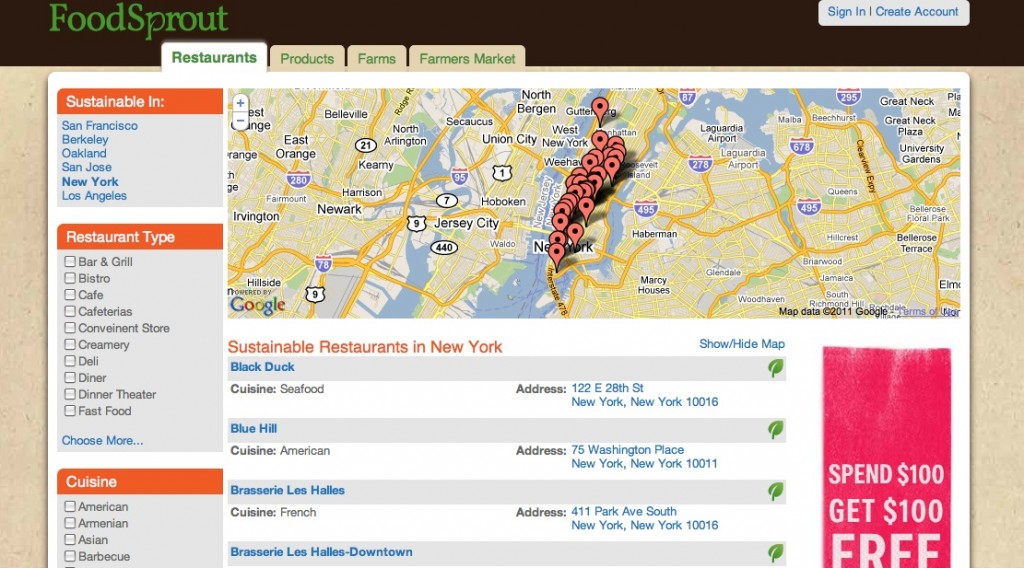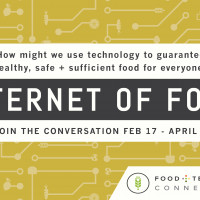Where does your food come from? The answer is more difficult than you might imagine. Thankfully, a growing number of tech savvy entrepreneurs are leveraging their Web2.0 acumen and the open government data movement to address the problem.
Food Sprout is a new, data-driven website that is mapping the food supply chain to improve transparency about where our food comes from. The site aims to connect consumers, restaurants, food manufactures, and suppliers to help companies become more sustainable and empower consumers to make better food decisions. Like Gourmet Origins and Real Time Farms, Food Sprout sees mapping as a powerful tool for helping people understand the stories behind their food.
My interview with Food Sprout Founder Andrew Naber is an interesting look at the data-driven business model and its challenges.
Danielle Gould: What is the inspiration behind Food Sprout?
Andrew Naber: For two years I worked for a local bakery that is available via Whole Foods. While there I began to see the vast complexity of our food system and didn’t really know what to do at the time, just knew it was a problem. After seeing the movie Food, Inc. the problem resonated with me in an entirely new way. It was obvious at that point that we needed more transparency around where our food comes from. As I did research, I also began to realize the impact growing all this food has on our planet. As a volunteer for the San Francisco Ocean Film Festival I also heard about the problem of over fishing the sea. With all of these problems staring us in the face I knew I had to act. With my background in Internet media I felt this was the logical place to start and that building a open platform for all to contribute would be the answer.
DG: How does the site work?
AN: Food Sprout works in many ways:
- Giving users access to data about their food
- As a resource for what really is sustainable food and what is not
- A research platform
- Tools for businesses
Right now the focus has been on building the front-end interface for users. Helping connect them to their food, what farms and suppliers local restaurants are supporting, and what food from the grocery is sustainable.
DG: Where does the product, restaurant, farm, and farmers market data come from?
AN: The data on Food Sprout comes from several places:
- Data our internal team at Food Sprout gathers
- Data a user inputs into the system that we then have to verify
- Third parties like non-profits supporting farmers that have data
- Government agencies and databases of food
- Investigative reporting where our team seeks out hard to find data
DG: What’s your business model?
AN: Our business model has several revenue streams:
- SaaS tools for companies
- Consulting using the data we have to help businesses
- Sponsorship/advertising on the front-end
DG: What have been the greatest challenges you’ve faced so far?
AN: Our greatest challenge so far has been speed of development and the complexity of the data. The more we dive into the data, and the more we build out features the more the problem reveals its complexity. The challenge is to simplify the data to help solve the problem and give businesses or consumers a quick score or “thumbs-up/down” for a particular food/method. Of course getting data from a big company like Subway is a lot like pulling teeth, only 10 times more painful and has also been a big challenge.
DG: How will mapping the food supply chain help to improve our food system?
AN: I feel like the more transparent we can make our food system, the more we can see it’s impact and therefore react accordingly to make changes and therefore make it healthier and more sustainable. At Food Sprout we are heavily data driven and want to quantify impact in a meaningful way. As we do that, we can help businesses move in a direction that has less of an impact on the environment and reduce the negative impacts on our health.
At the same time, demand to make these changes will also happen more rapidly as consumers start to vote with their dollars. We hope that as more people seek out this information they will find those businesses willing to be transparent and support them. In time the pressure and shift in sales dollars to these companies will help make the other companies change their ways.
DG: What is your definition of sustainable?
AN: My definition of sustainable is to operate in a closed system where the input and output equal net zero and can continue to replenish itself. For me, the system is everything from Earth to our local economies around small communities. To put that into a definition of food: if the output is the food on our table, the input would be everything from the farming, harvesting, processing, production and transportation of the food such that each step along the way is viable and can continue in a infinite loop. Understanding that we cannot continue to chop down forest and need to seek alternative methods of growing food using urban farms on roofs for example. Making sure we do not over fish so that fisheries can repopulate to healthy levels. If the food I’m eating doesn’t take into account these steps it isn’t sustainable.








